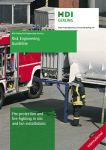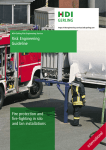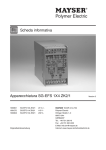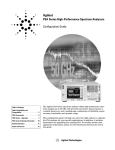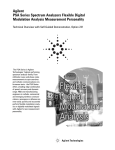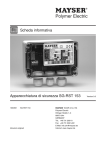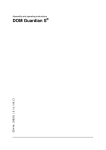Download Impairment of fire protection systems
Transcript
https://riskengineering-services.hdi-gerling.com HDI-Gerling Risk Engineering Services Risk Engineering Guideline Impairment of fire protection systems int er na tio na l Basic protection systems should not be impaired without adequate compensation. An impairment of fire protection systems increases the risk. In order to reduce the risk of fire during the impairment of fire protection systems, additional fire prevention measures must be taken. 1 Introduction Fire protection systems, as for example automatic fire extinguishing systems and automatic fire alarm systems, are essential components of fire protection concepts. They also provide a high success rate in extinguishing and/or detecting fires. Multiple examples of losses show that companies without adequate fixed fire protection in place often suffer a total fire loss with high property damage and business interruption claims. The efficiency and reliability of fixed fire protection is thus an essential factor to reduce potential fire damage and to maintain the business continuity of a company. In order to guarantee this to a maximum extent, repair works, periodic servicing and corrective maintenance to the fire protection systems cannot be avoided. Important: During an impairment, the risk of having a loss increases mainly because of two reasons: Firstly, the protection systems that are relevant for the safety are not in operation. Secondly, servicing and maintenance include activities that increase the risk of starting a fire. Proactive planning of the impairment plays an important role to ensure that servicing, maintenance and repair works are carried out properly as well to restore the fire protection system immediately after the works have been completed. This guarantees that the work can be carried out as smoothly as possible and that the fire protection system is again operational as quickly as possible. Risk Engineering Guideline: Impairment of fire protection systems For this reason, it makes sense to subdivide the measures for the impairment of fire protection systems as follows: • Measures before the impairment • Measures during the impairment • Measures after the impairment/restoration of the fire protection system 2 Risk situation Based on experience, the majority of losses happen outside of the “normal” operations. Why is the risk for a company increased specifically during repair, service and maintenance works? The reason is given by the fact that the adequate protection level is not provided and that activities can therefore be carried out outside everyday operations. Additionally, repair and service works often involve activities with an increased accident risk or ignition potential, such as welding, separating and cutting. In order to reduce the risk of fire during the impairment of fire protection systems, additional fire prevention measures must be taken. 3 Measures before the impairment Servicing, repair and maintenance works should be carried out by a (VdS-) accredited installer; preferably by the company that originally installed the fire protection system. The servicing company must be certified for the systems concerned. Basically, the planned impairment should be reported to HDI-Gerling (possibly via the insurance broker) at least 14 days before the start and any compensation measures required are to be clarified. (Attached form “Impairment notification”.) Unplanned interruptions (disruptions) are to be reported without any delay. If an unplanned impairment should occur during the night, HDI-Gerling (possibly via the insurance broker) is to be informed on the following day. This obligation to inform does not apply if it concerns the impairment of e. g. a single automatic fire detector – under the condition that monitoring of the area involved is not compromised. The impairment can only be instructed by an employee familiar with the areas and their associated risks and hazards. This should be closely coordinated with the fire safety officer. The instruction should be given in written form and after the impairment, the document is to be kept on file for at least half a year. The wide variety of different fire protection systems does not allow to go into detail on all necessary measures. This is why the following list of items does not pretend to be complete and should be adopted or extended to the respective fire protection system when required. Furthermore, reference is made to the relevant sections in the various (VdS-) guidelines to ensure the operational readiness or respectively for preventive measures and standard operating procedures if a system is not fully operational. 3 4 The following should be considered before the impairment: • Optimal preparation and organisation of the activities, in order to keep the impairment as short as possible. This includes, among others: ‒‒ the setting up of a time schedule, ‒‒ the provision of all required materials (e. g. replacement parts, seals etc.), ‒‒ the coordination of required specialised staff, ‒‒ the avoidance of work interruptions, e. g. of repair works during night-time periods, week ends or public holidays. • • Definition of the areas to be impaired: ‒‒ restriction to small sections if possible, ‒‒ no general impairment of the entire system. If work is being carried out on the pipework of an extinguishing system, only the respectively affected section should be shut off. If the zone protected by one section covers several rooms, appropriate measures should be taken, e. g. by insertion of blind flanges, protective caps, etc., to isolate the pipework only in the rooms where the work is being carried out. When work is being carried out on the water supply of (e. g. a sprinkler system), one source of water should be kept operational (compressed air water tank or pump) whenever possible or an alternative feed should be established. • When the only water supply for an extinguishing system is shut down or fails, an alternative water supply should be provided. If the system is equipped with a fire department connection (e. g. DN 150 with 4 x B-fitting), a hose connection should be set up between this connection and the next hydrant, integrating a booster pump if necessary. • Provision of suitable substitute systems (e. g. mobile fire alarm systems). • Provision of suitable manual fire extinguishing equipment (fire extinguishers, installation of fire hoses ready for use, etc.) combined with a fire watch, or at least an increased number of patrols, e. g. by guards. • Before a system is partially or completely impaired, all parts of the company site should be inspected in order to ensure that there are no hazards or signs of a fire. • If on a site with multiple users a common fire protection system is operated, all the users must be informed about the impairment of the system and joint compensation measures should be taken. • Notification of the responsible public fire brigade and the works fire brigade. • Notification of the employees, the plant management and the internal security/safety management. • Any work that involves a fire hazard, e. g. welding, cutting and burning operations, may not be carried out in the areas affected by the impairment or may only be carried out with strict adherence for the applicable safety regulations for operations involving fire hazards (see HDI-Gerling Risk Engineering Guideline “Hot works” and “Hot work permit”). • In order to be able to respond at short notice in case of an unforeseen impairment of fire protection systems, detailed procedures should be elaborated in advance. These are then immediately available whenever required. If fire alarm and extinguishing systems are a safety-relevant element of the building permit and the occupancy permit, this permit for use could be restricted in principle by this impairment. Additional protective measures defined by the responsible authority (e. g. fire protection service department) may have to be taken into account. Risk Engineering Guideline: Impairment of fire protection systems 4 Measures during the impairment The following should be considered during the impairment of fire protection systems: • Affixing of warning notices in protected areas and on components of the system, clearly indicating that the fire protection system is under impairment. Fire protection barriers, such as fireproof doors and fireproof dampers, should be closed during the impairment. • Hazardous or critical processes representing a fire risk should be discontinued to the maximum extent possible. • A fire watch should be provided, if possible by the fire brigade or a specialist fire protection company with appropriate communication equipment (radio links, mobile phones), in order to ensure that any fire alarm can be reported without any delay. If longer interruptions of the work are unavoidable, patrols should be carried out at intervals of maximum one hour. These patrols should be documented. • An increased number of control rounds must be carried out by trained and informed guards. • The use of third party companies within the affected area should be avoided. If the use of third party companies is unavoidable, they must be properly informed and trained in accordance with the situation. • If possible, the electrical power supply to the affected areas should be switched off. Impairment notification Restoration notification To be sent to your HDI or HDI-Gerling contact person/where applicable through your broker Company name: ................................................................................................................................................................................................. Responsible person: ........................................................................................................................................................................................... Street: .............................................................................................. Postal code, City: ...................................................................................... Policy number: ................................................................................. Herewith we declare that the Sprinkler system Water spray extinguishing system Foam extinguishing system Spark extinguishing system Local application extinguishing system, type: ...................................................................... Gas extinguishing system, gas type: .................................... Oxygen reduction system Automatic fire detection system Water-mist extinguishing system Powder extinguishing system ..................................................................... will be under impairment on .................................201...... for the estimated duration of ............................ hours/days. The design concentration of an oxygen reduction system may not be exceeded during the impairment of the system. Otherwise, the emergency concept agreed with the departments responsible for fire protection and personal safety security must be implemented (e. g. external supply with inert gas from a tanker). is under impairment since ....................................201...... The restoration of the system will probably follow within ............................ hours/days. is restored on ................................... 201...... at ............................ h. The target value of ....... % rest O2 of the oxygen reduction system is/will be reached on ................................ 201...... at ............................ h. Reason for the impairment: Extension/Change Repair works Maintenance Damage Other ........................................................................................ The following area is affected (please mention alarm valve, group, number of sprinklers, area, etc.): ................................................................... ................................................................................................................................................................................................................................ Precautions for the impairment: Production processes with an increased fire risk are suspended The area under impairment is kept as small as possible A ban on cutting and welding is valid for the duration of the Fire doors and fire dampers are closed impairment Appropriate alternative systems are put in place (e. g. mobile fire Closed valves are marked detection system) A person is posted at the control valve/pump for fast reaction in A fire watch is arranged case of a fire Pressurised fire hoses are ready for use A smoking ban is valid in the area concerned An emergency concept (e. g. external supply of N₂ for oxygen The public fire brigade is informed reduction systems, drains of the sprinkler system connected The works fire brigade is informed via a fire hose with a hydrant) Stops, blind flanges or similar spare parts are available on the spot Other: .............................................................................................. Ordered works are done without interruption Remark: .................................................................................................................................................................................................................. Date, Signature: ...................................................................................................................................................................................................... Precautions for the restoration: All armatures, switches on (automatic) operational readiness are checked and possibly padlocked in open position The pipes are all flushed after the works, a flush test was performed Pressure testing was done Warning signs indicating the impairment, as e. g. the marking of closed valves, are removed 1.14(I.14 500 N) • Smoking and open flames are strictly prohibited in the affected areas (avoidance of unnecessary ignition sources). 403-HGST249GB • • All parties involved in the process are informed (employees, safety organisation, public and private fire brigade, insurer/broker, etc.) The alarm system was reset and the alarm receiving station informed The full operational readiness of the system is confirmed in written by the company doing the activities needed during the impairment The activities were recorded in the service manual Other ............................................................................................... Remark: .................................................................................................................................................................................................................. Date, Signature: ...................................................................................................................................................................................................... Further explanations and examples of protection measures are listed in the HDI-Gerling Risk Engineering Guideline “Impairment of fire protection systems”. HDI-Gerling Sicherheitstechnik GmbH π HDI-Platz 1 π 30659 Hannover π www.hdi-gerling.de 5 6 Risk Engineering Guideline: Impairment of fire protection systems 5 Measures after the impairment Ensuring complete automatic operational readiness without delay should include the following: • Check of all fittings and switches for (automatic) operational readiness, if necessary securing in open/closed position with a pad-lock. • Performing a flushing test at the riser of a sprinkler system. • Notification of all departments involved in the process (employees, safety organization, public fire brigade or works fire brigade etc.). • Resetting the fire alarm control panel and notification of the alarm receiving station. • After the work has been completed, the full operational readiness of the system should be confirmed in writing by the specialist company carrying out the works. Furthermore, the activities should also be recorded in the logbook of the system. • Notification of HDI-Gerling (possibly via the broker) and – if necessary – the responsible public fire brigade and/or building permit authority about the restoration of the fire protection system. • Removal of the warning notices. If fire protection systems are under impairment, the risk of a major loss is increased, but can be reduced to an acceptable level by adopting the measures described above. 6 Note This Risk Engineering Guideline is not intended to be complete and does not provide any release from the duty of compliance with statutory or legal regulations. Any liability is excluded. Status: February 2014 Risk Engineering Guideline: Impairment of fire protection systems 7 Sources/references: VdS 2000: Not available in English VdS 2091en: Maintenance of operational readiness of water extinguishing systems VdS 2093en:CO₂-fire extinguishing systems, planning and installation VdS 2095en: Automatic fire detection and fire alarm systems, planning and installation VdS 2106en: Spark detection, spark separation and spark extinguishing systems, planning and installation VdS 2108en: Foam extinguishing systems, planning and installation VdS 2109en: Water spray systems, planning and installation VdS 2182: VdS 2241: Not available in English VdS 2304en: Local application protection for electric and elec- tronic equipment, planning and installation VdS 2380en: Fire extinguishing systems using non-liquefied inert gases, planning and installation VdS 2381en: Fire extinguishing systems using halocarbon gases, planning and installation VdS 2395: Not available in English VdS 2496en: Triggering of fire extinguishing systems, guidelines VdS 2893en: Maintenance of operational readiness of fire extinguishing systems with gaseous extinguishing agents VdS 3527en: Inerting and oxygen reduction systems, planning and installation Not available in English VdS 2212en: Log book for water extinguishing systems VdS 2240en: Log book for gas and powder extinguishing systems VdS CEA 4001en: Sprinkler systems, planning and installation 7 8 Risk Engineering Guideline: Impairment of fire protection systems About HDI-Gerling Risk Engineering Services 403-HGST/SIFI149GB 3.14(III.14 500 N) HDI-Gerling Risk Engineering Services supports mid-size companies, industrial companies and groups in preventing loss and damage, and in setting up a company risk management system. HDI-Gerling Risk Engineering Services also offers customers access to more than one hundred engineers and technical specialists from a wide range of different disciplines. The goal is to support companies in managing risks and working out an individual, risk-based concept for insurance cover. HDI-Gerling Risk Engineering Services operates across the world in the technical safety lines of Fire, Motor, Engineering Insurance and Marine. The focus of activities is on the identification and assessment of risks, and the development of appropriate, individual concepts for protection. HDI-Gerling Risk Engineering Services is part of the global Risk Engineering Network of the Talanx Group and a wholly owned subsidiary of HDI-Gerling Industrial Lines. HDI-Gerling Sicherheitstechnik GmbH HDI-Platz 1 - D-30659 Hannover Phone: 49-511-645-4126 Fax: 49-511-645-4542 Internet: www.hdi-gerling.de Imprint: In charge of the content: Clemens Lensing HDI-Gerling Sicherheitstechnik GmbH Layout: RELAY CORPORATE PUBLISHING GmbH. Printers: Lindendruck Verlagsgesellschaft mbH Pictures: HDI-Gerling Sicherheitstechnik GmbH, istockphoto.com: (by_ alactr, by_ bodo23, by_ SB-8NIHAT, by_ gordondix, by_ JimmiLarsen,) reinobjektiv, Although we made every effort possible to ensure the accuracy of the information provided, no liability can be assumed for the currentness, correctness and completeness of the information. We neither intend, nor assume any obligation, to update or revise these statements in light of developments which differ from those anticipated.








